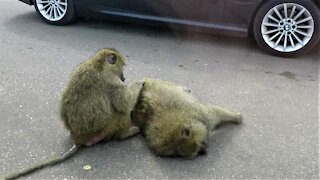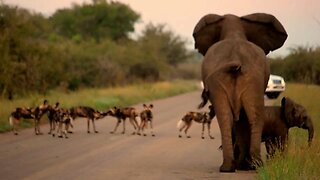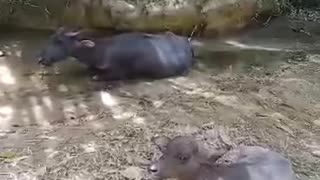Baboon Mother With Her Young Baby
Baboon mother with her young baby
Baboons are primates comprising the genus Papio, one of the 23 genera of Old World monkeys, in the family Cercopithecidae. There are six species of baboon: the hamadryas baboon, the Guinea baboon, the olive baboon, the yellow baboon, the Kinda baboon and the chacma baboon. Each species is native to one of six areas of Africa and the hamadryas baboon is also native to part of the Arabian Peninsula.[2] Baboons are among the largest non-hominoid primates and have existed for at least two million years.
What are baboons?
They are some of the world’s largest monkeys. There are five species of the baboon — olive, yellow, chacma, Guinea, and sacred — scattered across various habitat in Africa and Arabia. The olive baboon is the most extensively distributed of the baboon family. The baboon, like other Old World monkeys, does not have a prehensile (gripping) tail — meaning their tails are not used as a hand — but they are still able to climb when necessary. They all have dog-like noses, powerful jaws, sharp canine teeth, and thick fur. Males have a longer mane around the neck, called a ruff.
Females typically give birth after a six-month gestation, usually to a single infant; twin baboons are rare and often do not survive. The young baboon weighs approximately 400 g and has a black epidermis when born.
The females tend to be the primary caretaker of the young, although several females will share the duties for all of their offspring. After about one year, the young animals are weaned. They reach sexual maturity in five to eight years. Baboon males leave their birth group, usually before they reach sexual maturity, whereas females are philopatric and stay in the same group their whole lives.
Baboons in captivity have been known to live up to 45 years, while in the wild their life expectancy is between 20 and 30 years
Enjoy the video? More Animal Videos Here
https://rumble.com/playlists/LfbbQ3K-V2c
-
 0:27
0:27
F5Tornado
2 months agoA Family of Elephants See a Lion and Form a Circle to Protect Their Children
4882 -
 0:39
0:39
F5Tornado
3 months agoBaby Bear Cries Before Being Reunited with Mom
2.39K11 -
 1:24
1:24
KristysWorld
3 years ago $3.84 earnedBaboons casually stop traffic to groom each other on the road
3.64K3 -
 1:13
1:13
EmotionsofAfrica
3 months ago $86.58 earnedMother elephant protects baby from dangerous African wild dog
7081 -
 0:40
0:40
Viral Tab Animals
4 years ago $0.01 earnedFirst Footage Of Endangered Baby Monkey Born In France
331 -
 1:21
1:21
SPOTtheGOAT
4 months agoBaby Goats Febuary 2024
67 -
 1:24
1:24
EmotionsofAfrica
1 month ago $13.81 earnedAdorable moments between mother leopard and her playful cub in the wild
2391 -
 1:28
1:28
jonmary
1 month agoThe Mama Carabao and the baby Carabao resting under the bamboo tree
944 -
 0:44
0:44
SigneW
4 years ago $0.01 earnedcute monkeys playing together
119 -
 0:47
0:47
LoveBabyElephants
2 months ago $25.32 earnedCheeky baby elephant hilariously attempts to intimidate safari tourists
3151